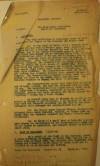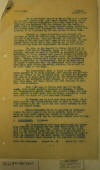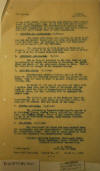|
|
G-2 report. |
3,020-d.
x-6,000 etc. |
 NICARAGUA
(Combat) NICARAGUA
(Combat)
Subject: The Nicaraguan
Revolution. (Military Situation)
From: M/A Nicaragua
Report No. 23 March
20, 1927.
1. ACTIVITIES:
The only activities of importance since
my last report were the fights at San
Geronimo and Tierra Azul.
(a) On the night of March 13/14 a
Liberal force of about 800 men with 25
machine guns, under command of Generals
Muller, a Latvian; Escamilla, said to be
a Mexican; […] Mena, son of the famous
Nicaraguan general, made a night march
from Muymuy and at daylight March 14th,
attacked the Conservative force of 700
men and 20 machine guns at San Geronimo.
Generals Reyes and Estrada were in
command of the Conservatives. After
about six hours of severe fighting the
Liberals withdrew, the Conservatives
capturing 2 machine guns, 80 rifles and
3,000 rounds of ammunition. About an
hour later the Liberals returned and
attacked vigorously. This second fight
lasted until about 3 o’clock p.m., when
both sides withdrew. The Conservatives
claim the victory, and explain they
withdrew because their ammunition was
exhausted. The Conservatives withdrew to
Mina Verde to reorganize and later to
San Ramon, where they now are. The
Liberals withdrew to Muymuy and later to
Matiguas.
The Conservatives report that they lost
27 killed and 38 badly wounded, and that
the Liberals lost at least 100 men. The
Conservatives also report having found
among the enemy dead 7 Mexicans,
identified by tattoo marks, clothing,
jewelry and their cheering for Calles
during the fighting; 1 German and 3
Costa Ricans.
As General Reyes came to Managua to
report on the battle in person to the
President, I am inclined to the belief
that the Liberals surprised him and that
he has overestimated their strength and
underestimated his own.
(b) The forces under General Viquez,
Conservative, attacked those under
Sandoval, Liberal, at Tierra Azul on
March 15th, but Sandoval withdrew his
forces without much resistance.
(c) On March 16th a small band of
Liberals captured near Sebaco two
automobiles of the Conservatives loaded
with 12,000 rounds of ammunition, and
escaped toward Rateli with their prize.
2. PLAN OF CAMPAIGN: (6,700-d)
As a result of the fight at San
Geronimo, about 5 miles northeast of
Muymuy, on March 14th, and the one at
Tierra Azul on March 15th, the Liberals
have withdrawn from Muymuy and Moncada’s
entire force of about 1,200 men is
reported to be at Matiguas and vicinity.
 p.
2 p.
2
The Conservative forces on March 18th
were located as follows: Tierra Azul
1,600 under General Viques, who is one
of the leading Conservative Generals;
Boaco 200; Teustepe 150; Las Banderas
178; Las Maderas 50; San Ramon, 5 miles
east of Matagalpa, 800 under General
Reyes; Jinotega 300; Cindad Dario 350;
Tipitapa 600 under general Rivers
Delgadillo, to be increased by 400 men
in two or three days.
General C. Rivers Delgadillo left
Managua for Tipitapa on March 18 with
400 men, 6 Browning machine guns and one
42 mm cannon. Upon his arrival at
Tipitapa the garrison of 200 men there
will pass to his command. He will remain
there two or three days pending the
arrival of 400 additional men from the
Departments of Masaya and Carazo.
The plan is for General C. Rivers
Delgadillo to assemble 1,000 men at
Tipitapa, which is 18 miles east of
Managua, and move as soon as possible on
Matiguas by way of Matagalpa, it is my
opinion that general Rivers Delgadillo’s
force will not reach its destination
until about the 1st of April. Whether
Moncada will attack before the
concentration is completed is
problematical, but if he does not it is
almost a certainty that the government
will wait until Delgadillo gets within
supporting distance, which will be at
least eight or ten days.
The Conservative plan is based on the
theory, which appears to be about
correct, that Moncada cannot subsist his
forces in the territory east and north
of Matiguas, and that if he moves from
there at all the movement must be either
to the southwest toward Managua or to
the west toward Matagalpa, and their
forces are well disposed to prevent such
movements.
With 1,600 men at Tierra Azul and 800 at
San Ramon, both within striking
distances of Moncada, I think the
Conservatives should attack him without
delay, but they have decided to wait
until General Rivers Delgadillo joins
them with his force of 1,000 men from
Tipitapa.
If Moncada can be held near Matiguas
until Delgadillo arrives the
Conservatives will be able to attack him
with between 3,500 and 4,000 men and
either destroy or capture his entire
force.
Unless Moncada’s force is captured or
destroyed within the next week or two it
is probable that it will split up into
small bands and resort to banditry and
guerilla warfare, which may be continued
almost indefinitely.
3. RECRUITMENT: (6,240-b)
The Conservatives have been mobilizing
and equipping recruits at Managua for
the past three weeks at the rate of
about 200 men per day. These recruits
are being sent to the various forces in
the field in detachments of from 100 to
300 men in an attempt to concentrate as
large a force as possible for the much
talked of decisive battle with the
Liberals under Moncada in the vicinity
of Muymuy.
 p.
3 p.
3
As the total number of men in the
Conservative army remains about the
same, 5,500 men, and as they have had no
engagements worth mentioning and
therefore have suffered very few battle
casualties, it is my opinion that their
recruitment rate equals that of their
desertions.
4. STRENGTH AND DISPOSITION: (6,180-a)
The Government forces are reported to
total 6,725 men and the Liberal forces
are variously estimated at from 1,000 to
2,000 men. My estimate is 5,500 for
Government and not to exceed 1,500 for
Liberals.
The disposition of both forces is shown
as of March 8, 11, 15 and 18 in the
attached table and as of Mar. 8 and 18
on the attached situation maps.
5. DISCIPLINE AND MORALE: (6,300)
Due to lack of interest in the war, lack
of pay, irregularity of supply and
absence of training, the discipline and
morale of the government forces is poor.
That of the Liberals is thought to be
slightly better.
6. NATIONAL GUARD: (6,100-a)
Twenty-eight student officers and men of
the National Guard are actively engaged
with the troops at the front. They are
used as aids to general officers,
machine gunners, etc.
On March 18, 100 men of the National
Guard with 3 machine guns were sent by
truck to Matagalpa and San Ramon to
guard the line of communications for
General Salvador Reyes, but they
probably will be employed for combat
duty.
The officers and men of the National
Guard or Constabulary, due to their
training and high morale, are much more
dependable than are those of the army.
7. GENERAL OFFICERS: (6,200-b)
The outstanding Conservative Generals
appear to be Bartolomo Viquez, Carlos
Rivers Delgadillo, Salvador Reyes and
Noguera Gomez. Those of the
revolutionists appear to be Jose Maria
Moncada, Luis Boltran Sandoval and
Recamilla.
8. AIR FORCE: (6,100-a)
The Government Air Force has been
reduced from two serviceable and one
unserviceable “swallow” planes to one
serviceable plane. There are no spare
parts or facilities for repairing the
unserviceable planes.
Sources: American Legation, Nicaraguan
Govt., Major Rodriguez, other reliable
informants & personal observation.
3 enclosures.
A. W. Bloor,
Military Attaché.
United States National Archives, College Park
MD, Record Group 165, Entry 77, Box 2660.
Transcribed by Nicholas J. Quadrini.
|

